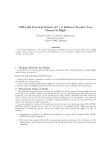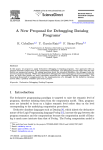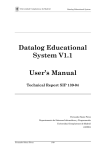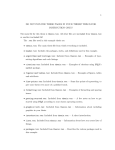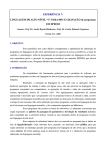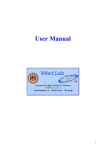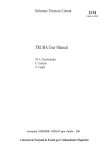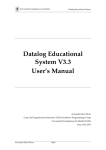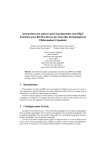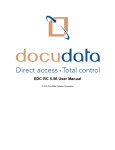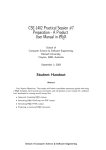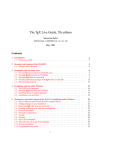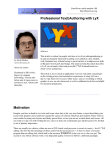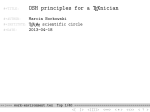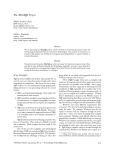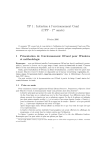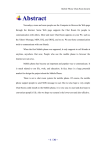Download PDF version of paper
Transcript
The PracTEX Journal, 2007, No. 3
Article revision 2007/08/12
ACIDE: An Integrated Development
Environment Configurable for LATEX
Fernando Sáenz-Pérez
Website http://www.fdi.ucm.es/profesor/fernan
Address Facultad de Informática, Universidad Complutense de Madrid, Spain
Abstract This article introduces the configurable integrated development environment ACIDE, which is an ongoing development project currently in alpha
status. It is cross-platform, open-source, and free, and will be distributed
under GPL. Although targeted to any programming language environment,
including compilers, interpreters, and database systems, in particular it is
well-suited to tasks required for LATEX and TEX document preparation systems. It manages projects, is useful in dealing with multifile documents, allows configurable menus, has a toolbar for executing commands and lexical
tokens for syntax colouring, and even grammars to identify programming
(syntactical) errors on the fly.
Keywords: Tools, Free, Open-source, Cross-platform, Editor, IDE, LATEX, TEX
1
Introduction
As a system implementor of declarative languages (e.g., the constraint functional
logic language Toy [16], and the Datalog Educational System DES [17]), I needed
an Integrated Development Environment (IDE) for each of them. Because of the
need to work with several languages, developing a configurable IDE was almost a
necessity. Therefore, during the course “Computing Systems” (which belongs to
a postgraduate study), I directed a team of students in developing such a system
which we called A Configurable IDE (hence the acronym ACIDE). The benefits
are not only for system implementors who need an IDE for their systems, but
also for other users, such as database users, and more importantly for readers
of this journal, who can use it as already configured for LATEX and TEX (cf. the
suggestions in Section 4).
Copyright © 2007 Fernando Senz-Prez.
Permission is granted to distribute verbatim or modified
copies of this document provided this notice remains intact.
The requirements of this project were several-fold:
Configurable The main objective of this system is to be as highly configurable as
possible, keeping the configurations easy and portable by means of text files. This
configuration includes menus, a toolbar for executing commands, lexical tokens
for syntax colouring, and even grammars to identify programming errors on the
fly.
Simple We looked for, first, a simple, intuitive GUI. Second, a system that can
be easily configured for a requested programming system, both the language
lexicon as well as its grammar. Third, it must be easily installed, even requiring
no installer. In fact, only decompressing an archive and executing a file should be
enough to start working with the system. And, fourth, to have a simple multifile
editor for basic users, which can also be used by advanced users who need extra
features (projects, language configurations, etc., see Sections 2 and 3)
Internationalized In order to have a wider audience, text files are used to define
all the texts of the GUI, so that the system can be easily localized to different
languages.
Open-source We do believe that the open-source alternative will produce better
software and systems, and allow developers to contribute enhancements. This is
fitting in a university context, so that students will have sources available to learn
and practice with them. In an unusual step, the project’s main application has
been developed without using other software as a basis. While doing this would
have allowed more rapid development, starting from scratch gave the students
a unique opportunity, one of the few they will probably have in their careers.
Nonetheless, another free and open-source project ANTLR [2] has been used for
parsing.
A Cross-Platform System Despite the basic need to develop the same system for
several platforms, many of us use several different operating systems and therefore want to have the same applications available on several platforms. As a consequence, the selected development language was Java, which is widely known
2
and works on any platform. Of course, this was not the only alternative, since
one can use C#, for example. But for developing a cross-platform system that can
be widely used and modified in an open-source project, Java was chosen.
Free One of our goals in the university is to share knowledge, and we make
our work freely available to others. Further, providing free software allows for
widespread usage. In addition, our university and several national projects support us as researchers and lecturers (see Section 6), so we do not need additional
income from developing the software.
Before starting to develop this project, other related systems were analysed.
On the one hand, there are multi-file editors such as JEdit [9], which is free, crossplatform, configurable and with many nice features. However, JEdit is targeted as
a file editor, not as an IDE, and lacks features such as parsing and shell. Crimson
Editor [5] is a Windows editor also configurable and allows writing commands
to send to a shell in order to do code compilations and run executables. However,
it also lacks parsing capability, and moreover it is not cross-platform.
On the other hand, there are several IDEs which can be categorised into specific or general purpose. Specific IDEs can also be configured in various ways. For
instance, WinEdt [14] is a Windows editor highly targeted to LATEX and TEX documents, and it is quite powerful for this document preparation system. However,
it is neither cross-platform, nor free, nor open-source. Other free IDEs are LaTeX
Editor [10], WinShell [15], and TexnicCenter [13] (all of these only for Windows),
Texmaker [12] (free and open-source), LyX (a WYSIWYM document processor for
*nix platforms), and several others. JBuilder [7] and JCreator [8] are examples
of commercial software for programming IDEs that also may provide hints for
detected functionalities requested by users. But maybe the best exponent of an
open-source, free project is Eclipse [6], which is a development platform comprised of extensible frameworks, tools and runtime libraries for building, deploying and managing software, and it comes with many programming environments
already configured. The main drawback is that it cannot be easily configured to
deal with programming environments other than the ones it uses.
Therefore, having stated our original goals and reviewed related systems, we
conclude that no system completely fits our requirements, and that our proposal
might be of interest for other users. In particular, LATEX/TEX users might find an
3
alternative to existing editors. Note, however, that our system is emerging and is
in a very early development stage, but its future development will be guided by
the aforementioned objectives as well as user feedback.
The next sections describe the system. First, Section 2 states the concrete
features of the system as well as its main current limitations. Section 3 describes
ACIDE from a user point-of-view. Section 4 summarises an instance of the system
configured for LATEX. In Section 5 some conclusions and future work are noted.
Finally, acknowledgements are offered (Section 6).
2
Features and Limitations
This section first describes the inherent features of ACIDE, although not all of
them or their functionalities are fully operational in the current development
stage. In addition, some limitations of the system are noted.
2.1
Features
– Multi-File Editor. Many files can be opened and two views for the same file
and window are possible. The usual copy, paste, undo, and redo operations
are possible via contextual menus and application menus. File printing is
also provided. Syntax, programming errors, and delimiter pairs (parentheses, square brackets, . . . ) are highlighted.
– Configurable. Menus, toolbar, syntax highlighting (which includes tokens,
delimiters, and remarks), parsing (from an EBNF language description),
compiler, shell, and GUI language (currently localised to English and Spanish). Tool variables are provided to configure the commands assigned to the
toolbar. For instance, $activeFile$, which keeps the complete file name of
the selected file in the tool.
– Text-based Configuration. This tool allows configuration of all of its parameters by the use of text files, which permits using the provided dialog
boxes without the need to resort to manually encode the data in the plain
text files, as well as editing these files with a text editor, and even generate
them with applications. For instance, one could generate the lexicon of a
language from its formal description (e.g., EBNF).
4
– Project Management. Logical views of projects arranged in folders, which
contains files or other folders. A concrete file can be selected as compilable
or as a main file for a compilation. Also, several files can be selected for
compilation by specifying the file extension.
– Logging. For implementation purposes, a log has been added, which helps
in developing the tool.
2.2
Limitations
– Macros. They are quite helpful for defining scripts inside the tool. Currently,
this task has to be passed to the operating system. That is, we can define
a command as a system call, which can be a batch or script file. Toolbar
commands might use these macros.
– Debugging. An almost indispensable feature for programming, but with
current limitations: the tool can only handle debugging an interpreter with
input/output via the standard streams. It can be used with toolbar buttons,
therefore easing the task. Think, for instance, of the debugging model of
Prolog.
– Menu Commands. There is a prefixed set of menu commands which can
be enabled or disabled, but it is not possible to define new menu commands
in the same way they are defined for the toolbar.
– Command History. This is quite useful for the shell, and also provides an
autocompletion feature.
– Dictionary. A feature which operates the opposite of syntax highlighting,
in that unrecognised words are highlighted, and in addition suggestions are
provided for fixing errors.
– Editor Facilities. Other features can be useful, such as shorthand methods
for completing text fragments (e.g., type ltx and get \LaTeX), text autocompletion, case changing, word wrapping, patterns (e.g., LATEX environments as itemize, therefore automatically filling \begin{itemize}, \item,
and \end{itemize}), autoindent, font selection for editor windows and console, and many other features.
5
In addition to this short list, it is possible to find many more limitations. Here,
the most important ones, in our view, have been listed.
3
Description
3.1
Technology
The implementation of the tool has been completely done using Java under Eclipse.
Version control was kindly provided by Berlios [3]. Students prepared the documentation using Rational Rose for UML diagrams, MS Project for Gantt charts,
and MS Word. It seems that our graduate students do not feel the need for more
powerful text editing when working with LATEX.
3.2
The Main GUI
Figure 1 shows the main GUI of ACIDE. It consists of three main panels. The
left panel shows the organisation of the current project, the MDI windows in the
right are the opened files which may belong to the project (files may be opened
without assigning them to the project). Below, the shell panel is shown, which
allows user interaction. The case shown is a command console of Windows XP.
Both the shell and project panels can be hidden. Moreover, there is no need to
work with projects if this flexibility is not needed; a regular user may use the
system as is. The status of the GUI is remembered for the next time the tool is
executed. If the tool opens a project, its status when it was last saved is restored.
The menu bar includes some common entries:
– File. For file-related operations (New, Open, Close, Close All for closing all
opened files, Save, Save As, Save All, Print and Exit). Missing useful options:
Recent Files.
– Edit. For clipboard-related operations, search, undoing changes, and go
to line number. Missing useful options: Select All, Insert Comment, Remove
Comment.
– Project. For project-related operations (New Project, Open Project, Close Project,
Save Project, Save Project As, Add File to the current project, Remove File from
the current project, New Folder in the project structure, Delete Folder from the
6
Figure 1: ACIDE Main GUI
project structure, Compile the specified files (see Section 3.5.3), Execute the
result of the compilation, Set File as Compilable, Unset File, and Set as Main
File). Missing useful options: Recent Projects.
– View. For showing/hiding project and shell panels, and displaying the log.
Window arrangements are not possible up to now, but usual features are
cascading and tiling windows both vertically and horizontally. Changing
the order of the MDI windows (tabs) is not possible.
– Configuration. This entry allows to configure Lexicon (for syntax highlighting), Grammar (for parsing on-the-fly), Compiler (for compiling the project),
Shell (the shell in the bottom panel), Language of the GUI, Menu entries that
are displayed, and Toolbar for the commands, which can be displayed ei7
ther as icons or textual descriptions. Tooltips for toolbar commands can be
configured.
– Help. This entry contains Show Help, and About ACIDE.
In addition, there is a fixed toolbar which includes common buttons for file
and project-related basic operations: New, Open, Save, and Save All (this last one
only for files). For development purposes, a button with label Syntactic analysis
is included, and it is intended to test text parsing. Currently, a fixed grammar is
included, but it will be specified by the user (see Section 3.5.2). Next to the fixed
toolbar, there is the configurable toolbar (see Section 3.5.5).
Finally, the status bar gives information about some items: The complete path
of the selected file, the selected grammar and lexicon, the line and column numbers, Caps Lock, Scroll Lock, Num Lock, and current time.
3.3
ACIDE System Variables
There are two system variables which are used for configuring commands in the
toolbar, and also for configuring compiler options and the executable file:
– $activeFile$. Contains the complete file name of the current file (the one
in the active MDI window).
– $mainFile$. Contains the complete file name of the main file (the one manually marked with Set as Main File).
In both cases, it is also useful to access only the name of the file or the extension, an issue to be addressed soon.
3.4
Projects
A project contains the whole status of a session, which is defined by all the possible configurations as well as the current display status. It consists of files arranged in folders (with any tree depth), all the configurations for the session
(lexicon, grammar, compiler, shell, language, menu, and toolbar), main GUI arrangement (panel sizes, and opened files in the project), and file attributes. File
attributes identify a file in a project as compilable and/or main. If a file is compilable, then the compiler configuration can be set to compile each of these files.
8
If a file is a main file (there is only one in the project), then it can be used in the
compiler configuration or in the toolbar commands. For instance, a LATEX project
would compile the main file whether it is opened and active in the multifile panel
or not. The filename of the main file can be accessed with the system variable
$mainFile$.
The project structure shown in folders is a logical view which may coincide
with the physical structure of the OS folders, but this is not needed. You can
include in a given project a file belonging to another tree structure, therefore
allowing to share files for different projects.
3.5
Configuration
Next, possible configurations are briefly described.
3.5.1
Lexicon
The lexicon for a programming or description language can be configured (as
shown in Figure 2) for implementing a useful feature in text editors: syntax highlighting. Our tool allows defining the tokens and their associated format (colour,
bold face and/or italics). Also, delimiters are needed to detect each token and
these can also be declared. Line comments start with a given string; “%” in LATEX,
for instance. Also, a colour can be specified for comments.
3.5.2
Grammar
Both lexical categories and syntax rules can be defined to configure a grammar in
EBNF (see Figure 3). Our tool allows the user to type or load those and create a
parser, which is generated with the open-source, free project ANTLR [2] (ANother
Tool for Language Recognition). With this tool the user will be able to activate
parsing on-the-fly, a valuable aid in avoiding programming errors. This feature
is still under development and it is expected to be completed by September 2007.
3.5.3
Compiler
A dialog box allows definition of the compiler to be used, its parameters, and the
files to compile (see Figure 4). These files can be the files in the project that the
9
Figure 2: Lexicon Configuration
10
Figure 3: Grammar Configuration
user sets as compilable (a menu entry in the Project menu) or the files with a given
extension (e.g., .java). Here, only the main file is compiled; there is no need to
compile others. This dialog is useful for other programming environments in
which several files must be compiled.
3.5.4
Executable
For programming projects that generate an executable, this dialog box allows the
user to define the file’s location as well as its arguments, if any (see Figure 5). The
entry Execute in the menu Project will execute this file.
11
Figure 4: Compiler Configuration
Figure 5: Executable Configuration
3.5.5
Toolbar
The toolbar can be configured by adding icons to the toolbar, which are associated
with user-defined commands (see Figure 6). Currently, toolbar commands are
sent to the console in the shell panel, but sending them as a separate process is
also needed (a pending issue).
3.5.6
Menu
The menu bar can be configured by enabling or disabling predefined entries (see
Figure 7). This configuration has to be extended to user-defined commands, as in
the toolbar.
12
Figure 6: Toolbar Configuration
13
Figure 7: Menu Configuration
14
3.5.7
Shell
The shell can be configured with the dialog box seen in Figure 8. The check box
is used for echoing the input command when the shell reads the input but does
not output it.
Figure 8: Shell Configuration
4
Configuring ACIDE to Work in a LATEX Environment
Following the previous section, it becomes clear that ACIDE can be configured
to work in a LATEX/TEX environment. At least, in the current development stage,
the following can be configured (actually, they are):
– Lexicon: For syntax highlighting as seen in Figures 1 and 2.
– Toolbar commands: TeXify (latex+bibtex+latex+latex), LaTeX (latex), BibTeX
(bibtex), Yap, and dvi2pdf (dvi2pdf) among others (see Figures 1 and 6).
– Shell: For interacting with an operating system console (see Figures 1 and
8).
– Compile project: For compiling the main file (see Figure 4).
15
5
Conclusions and Future Work
This paper has presented ACIDE, an alternative to other available IDEs, with
features meeting our initial requirements. It cannot be thought of as a complete
tool since it is emerging and in an alpha development status. It should otherwise
seen as a tool that, in time, might provide a steady stream of features following
our requirements. For LATEX/TEX users, there are much better tools in the free
market today, but ACIDE might be competitive once it is more mature.
There are many goals yet to be completed. Some have been posed in Section 2
and others have been indicated in the following sections, while some have become
evident after the tool description and configuration. Apart from fixing numerous
bugs (including operating system dependent calls, which makes this tool work
only for Windows, up to now), we have to implement state-of-the-art features
in file editors, programming environments, and shell interactions. Despite the
assumed limitations, we hope that this tool will consolidate into a friendly and
powerful application, amenable to the users for whom it is designed; in particular,
to system implementors, database users, document writers, and developers. It
can be downloaded from http://acide.sourceforge.net. We hope to provide
the version described in this paper as soon as possible, and to provide a better
and more stable implementation by September 2007.
6
Acknowledgements
I am grateful to the students who developed this system under my guidance,
which I hope will be useful for them as they develop their own projects in the future. These students are Diego Cardiel Freire, Juan José Ortiz Sánchez, and Delfı́n
Rupérez Cañas, who worked on this project in the computer science course “Sistemas Informáticos” (Computing Systems) for graduates, a course intended for
fifth-year students of the Computer Engineering studies of the Computer Science
Faculty at the Universidad Complutense de Madrid, Spain. Also, thanks to the
projects TIN2005-09207-C03-03, and S-0505/TIC0407 which supported this work.
Finally, thanks to the free, open-source project ANTLR [2] which we use in our
project, as well as to the Java and Eclipse initiatives. This article was prepared
with MikTeX 2.4 [11], ACIDE [1] (cf. Figure 1), and BibMgr [4].
16
References
[1] ACIDE. A Configurable Integrated
http://acide.sourceforge.net.
Development
Environment.
[2] ANother Tool for Language Recognition. http://www.antlr.org.
[3] Berlios. http://www.berlios.de.
[4] Bib Manager and Word Citer. http://bibmgr.sourceforge.net.
[5] Crimson Editor. http://www.crimsoneditor.com.
[6] Eclipse. http://www.eclipse.org.
[7] JBuilder. http://www.borland.com/jbuilder.
[8] JCreator. http://www.jcreator.com.
[9] JEdit. http://www.jedit.org.
[10] LaTeX Editor. http://www.latexeditor.org.
[11] MikTeX. http://www.miktex.org.
[12] Texmaker. http://www.xm1math.net/texmaker.
[13] TexNicCenter. http://www.toolscenter.org.
[14] WinEdt. http://www.winedt.com.
[15] WinShell. http://www.winshell.org.
[16] P. Arenas, A.J. Fernández, A. Gil, F.J. López-Fraguas, M. Rodrı́guezArtalejo, and F. Sáenz-Pérez. T OY . A Multiparadigm Declarative Language. Version 2.3.0, 2007. R. Caballero and J. Sánchez (Eds.), Available
at http://toy.sourceforge.net.
[17] F. Sáenz-Pérez. Datalog Educational System User’s Manual. Technical Report 139-04, Facultad de Informática, Universidad Complutense de Madrid,
2004. http://des.sourceforge.net.
17


















